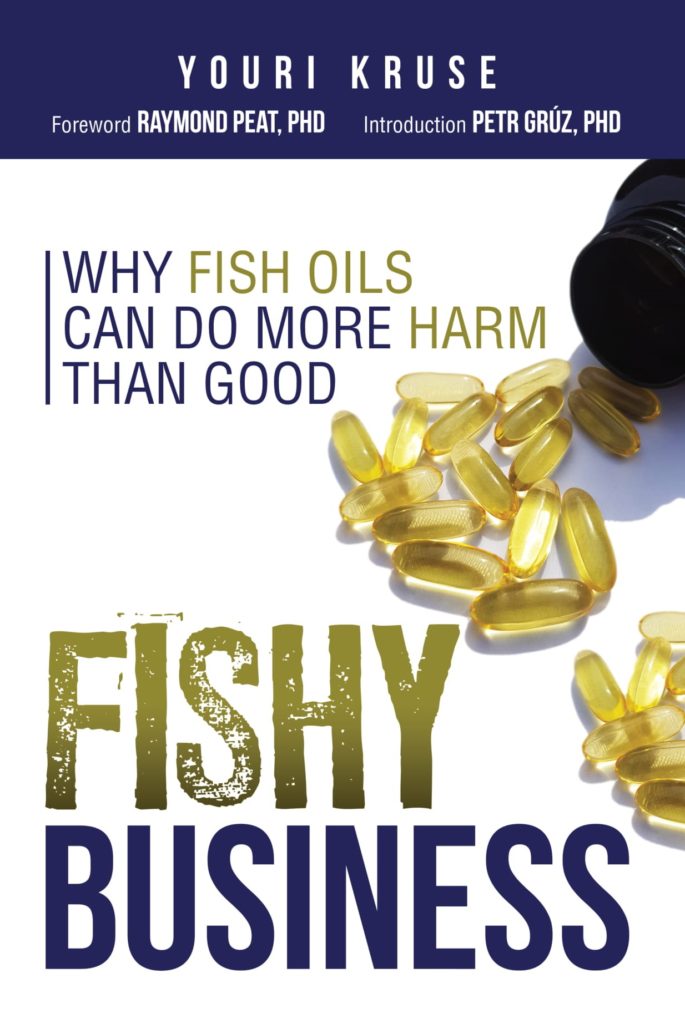Fish oils can break down in many hundreds of breakdown products. There are, however, more famous breakdown products than others. let see the most important ones
- Acrolein, interestingly, the omega 3 oils produce more acrolein and crotonaldehyde than omega 6![1], (methyl oleate did not show any acrolein[2], acrolein is used as a long term oxidative marker for increased chances of atherosclerosis and diabetes[3]). Acrolein formation is higher with fish oil than omega 6 oils[4]. Of the vegetable oils, the precursor of fish oils, ALA, had the greatest formation of acrolein[5] (acrolein is implicated in the promotion of asthma[6] and inhibits testosterone production[7]).
- Crotonaldehyde, is implicated in liver tumors[8] Alzheimer disease[9], mitochondrial damage[10]
- Acrylamide, is associated with infertility[11] neurotoxicity[12] and increases nitric oxide and cycloogenase-2 (Cox-2)[13]. The formation of acrylamide is highest with fish oil and lowest with beef and lard (sardine oil (642 microg/g asparagine) > cod liver oil (435.4 microg/g) > soybean oil (135.8 microg/g) > corn oil (80.7 microg/g) > olive oil (73.6 microg/g) > canola oil (70.7 microg/g) > corn oil (62.1 microg/g) > beef fat (59.3 microg/g) > lard (36.0 microg/g)[14].
- Melondialdehyde, is also used as a marker as oxidative status[15], and possibly for ageing[16].
- 8-hydroxydeoxyguanosine (8-OHdG), is another break down product of omega 3 fatty acids. 8-OHdG is the most frequent detected and studied DNA lesion. 8-OHdG furthermore is link for increased risk for cancer, diabetes and atherosclerosis[17]. DHA increase 8-OHdG (especially in old test subjects)[18] and is increased in omega-3 versus the omega-6[19].
If you like what you are reading, read more here

[1] J Agric Food Chem. 2015 Jul 22;63(28):6293-6. doi: 10.1021/acs.jafc.5b02376. Epub 2015 Jul 9. Reactive Carbonyl Species Derived from Omega-3 and Omega-6 Fatty Acids. Wang Y, Cui P.
[2] Journal of the American Oil Chemists’ Society. July 2013, Volume 90, Issue 7, pp 959–964 Linolenic Acid as the Main Source of Acrolein Formed During Heating of Vegetable Oils. Yasushi Endo, Chieko Hayashi, Takashi Yamanaka, Koichi Takayose, Miki Yamaoka, Takuo Tsuno, Shigeo Nakajima
[3] Proc Natl Acad Sci U S A. 1998 Apr 28;95(9):4882-7. Protein-bound acrolein: potential markers for oxidative stress. Uchida K, Kanematsu M, Sakai K, Matsuda T, Hattori N, Mizuno Y, Suzuki D, Miyata T, Noguchi N, Niki E, Osawa T.
[4] Journal of the American Oil Chemists’ Society. December 2015, Volume 92, Issue 11, pp 1661–1670. Formation of Acrolein in the Autoxidation of Triacylglycerols with Different Fatty Acid Compositions. Ako ShibataMariko UemuraMasashi HosokawaKazuo Miyashita.
[5] Endo, Y., Hayashi, C., Yamanaka, T. et al. J Am Oil Chem Soc (2013) 90: 959. doi:10.1007/s11746-013-2242-z
[6] Acrolein Induction of Oxidative Stress and Degranulation in Mast Cells. 2012 Daniel J. Hochman, Christopher R. Collaco, Edward G. Brooks Department of Pediatrics, University of Texas Medical Branch, 301 University Blvd., Galveston, Texas 77555-0369
[7] Effects of maternal acrolein exposure during pregnancy on testicular testosterone production in fetal ratsYUZHUO YANG1, ZHE ZHANG1, HONGLIANG ZHANG2, KAI HONG1, WENHAO TANG1, LIANMING ZHAO1, HAOCHENG LIN1, DEFENG LIU2, JIAMING MAO2, HAN WU1 and HUI JIANG11Department of Urology and 2Reproductive Medicine Center, Peking University Third Hospital, Beijing 100191, P.R. ChinaReceived November 24, 2015; Accepted November 29, 2016.
[8] Cancer Res. 1986 Mar;46(3):1285-9. Induction of liver tumors in F344 rats by crotonaldehyde. Chung FL, Tanaka T, Hecht SS.
[9] Acta Neuropathologica. May 2006, Volume 111, Issue 5, pp 422–429. Crotonaldehyde accumulates in glial cells of Alzheimer’s disease brain. Motoko Kawaguchi-Niida, Noriyuki Shibata, Shunichi Morikawa, Koji Uchida, Tomoko Yamamoto, Tatsuo Sawada, Makio Kobayashi
[10] Pharmacol Res. 2014 Apr;82:40-50. doi: 10.1016/j.phrs.2014.03.010. Epub 2014 Apr 3. α,β-Unsaturated aldehyde crotonaldehyde triggers cardiomyocyte contractile dysfunction: role of TRPV1 and mitochondrial function. Pei Z1, Zhuang Z2, Sang H3, Wu Z4, Meng R5, He EY6, Scott GI7, Maris JR7, Li R8, Ren J9.
[11] Reprod Toxicol. 2003 Jan-Feb;17(1):1-13. Effects of acrylamide on rodent reproductive performance. Tyl RW1, Friedman MA.
[12] Acta Neuropathol. 1982;58(3):210-4. Selective loss of Purkinje cells from the rat cerebellum caused by acrylamide and the responses of beta-glucuronidase and beta-galactosidase. Cavanagh JB, Nolan CC.
[13] Toxicol Ind Health. 2011 Feb;27(1):11-8. doi: 10.1177/0748233710380217. Epub 2010 Aug 16. Food contaminant acrylamide increases expression of Cox-2 and nitric oxide synthase in breast epithelial cells. Lyn-Cook LE Jr1, Tareke E, Word B, Starlard-Davenport A, Lyn-Cook BD, Hammons GJ.
[14] Adv Exp Med Biol. 2005;561:223-33. Formation of acrylamide from lipids. Ehling S1, Hengel M, Shibamoto T.
[15] Wiad Lek. 2004;57(9-10):453-5. [Malondialdehyde (MDA) as a lipid peroxidation marker].Gaweł S1, Wardas M, Niedworok E, Wardas P.
[16] Gerontology. 2002 Jul-Aug;48(4):209-14. Malondialdehyde: a possible marker of ageing. Gil P1, Fariñas F, Casado A, López-Fernández E.
[17] Clin Chim Acta. 2004 Jan;339(1-2):1-9. Urinary 8-OHdG: a marker of oxidative stress to DNA and a risk factor for cancer, atherosclerosis and diabetics. Wu LL1, Chiou CC, Chang PY, Wu JT.
[18] Free Radic Res. 2001 Apr;34(4):427-35. Docosahexaenoic acid supplementation-increased oxidative damage in bone marrow DNA in aged rats and its relation to antioxidant vitamins. Umegaki K1, Hashimoto M, Yamasaki H, Fujii Y, Yoshimura M, Sugisawa A, Shinozuka K.
[19] Am J Clin Nutr. 2012 May;95(5):1209-14. doi: 10.3945/ajcn.111.030817. Epub 2012 Mar 21. PUFAs in serum cholesterol ester and oxidative DNA damage in Japanese men and women. Kimura Y1, Sato M, Kurotani K, Nanri A, Kawai K, Kasai H, Imaizumi K, Mizoue T.